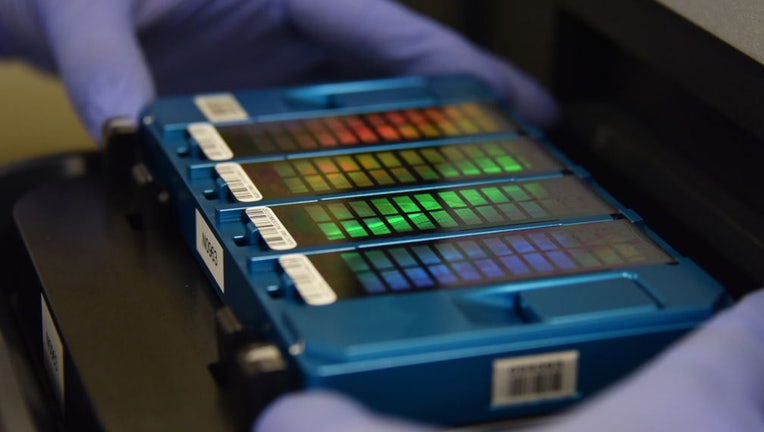Scientists sequence first-ever complete human genome

FILE - A technician places an array containing DNA information in a scanner. (GREG BAKER/AFP via Getty Images)
Nearly 100 scientists rallied together to complete the first-ever completed human genome sequence, creating the first-ever blueprint for human life.
On April 1, contributors from the Telomere-to-Telomere (T2T) Consortium managed to sequence the remaining 8% of the human genome, an effort left over from the Human Genome Project (HGP).
HGP was started in 1988 by a special committee of the U.S. National Academy of Sciences and was an international, collaborative research program whose goal was the complete mapping and understanding of all the genes of human beings.
Beginning on October 1, 1990, and completed in April 2003, the HGP gave people the ability to read nature's complete genetic blueprint for building a human being, according to the National Human Genome Research Institute. But there were still a few gaps.
HGP was only able to sequence 92% of the human genome in 2003. This year, T2T filled in the remaining 8%.
How long did it take?
The combined efforts by HGP and T2T took a little over 31 years to accomplish, which might sound like a long time for something so tiny but reading DNA is extremely tedious.
Since 2003, scientists worked to fill in the gaps HGP left behind, according to T2T.
The first sequence was incomplete because DNA sequencing technologies of the day weren’t able to read certain parts of it. Even after updates, it still had missing parts.
"Some of the genes that make us uniquely human were actually in this ‘dark matter of the genome’ and they were totally missed," said Evan Eichler, a University of Washington researcher who participated in the current effort and the original Human Genome Project. "It took 20-plus years, but we finally got it done."
How does it work?
The human genome is made up of about 3.1 billion DNA subunits, pairs of chemical bases known by the letters A, C, G and T. Genes are strings of these lettered pairs that contain instructions for making proteins, the building blocks of life. Humans have about 30,000 genes, organized in 23 groups called chromosomes that are found in the nucleus of every cell.
To find such genes, scientists needed new ways to read life’s cryptic genetic language.
Reading genes requires cutting the strands of DNA into pieces hundreds to thousands of letters long. Sequencing machines read the letters in each piece and scientists try to put the pieces in the right order. That’s especially tough in areas where letters repeat, the Associated Press noted.
Scientists said some areas were illegible before improvements in gene sequencing machines that now allow them to, for example, accurately read a million letters of DNA at a time. That allows scientists to see genes with repeated areas as longer strings instead of snippets that they had to later piece together.
Researchers also had to overcome another challenge: Most cells contain genomes from both mother and father, confusing attempts to assemble the pieces correctly. T2T researchers got around this by using a cell line from one "complete hydatidiform mole," an abnormal fertilized egg containing no fetal tissue that has two copies of the father’s DNA and none of the mother’s.
Why is this important?
Scientists said this full picture of the genome will give humanity a greater understanding of our evolution and biology while also opening the door to medical discoveries in areas like aging, neurodegenerative conditions, cancer and heart disease.
"We’re just broadening our opportunities to understand human disease," said Karen Miga, an author of one of the six studies published on March 31.
T2T’s work adds new genetic information to the human genome, corrects previous errors and reveals long stretches of DNA known to play important roles in both evolution and disease.
What’s next?
The Human Pangenome Reference Consortium is now trying to generate "reference," or template, genomes for 350 people representing the breadth of human diversity.
"Now we’ve gotten one genome right and we have to do many, many more," Eichler said. "This is the beginning of something really fantastic for the field of human genetics."
The Associated Press contributed to this report. This story was reported out of Los Angeles.

